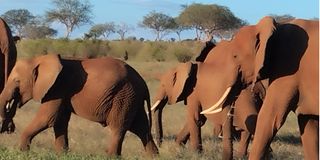The red elephants of Tsavo

The Red Elephants of Tsavo East National Park. Photo | RUPI MANGAT
What you need to know:
It’s like entering a peaceful haven that has seen the story of Tsavo unfold from its devastating drought in the 1960s to the traumatic poaching of the 70s
The red earth road leads us towards Kilimanjaro standing regal in the horizon. There are rumours that there are elephants in Makindu, most famous for housing the Makindu Sikh Temple, revered by Sikhs from all over the world. It has to do with the Sikhs arriving in the 1890s as part of the workforce from India to construct the Uganda Railway.
In the eventide, driving along the rural road it seems unbelievable that there would be elephants here. But then we see them browsing peacefully with the baobabs standing stoic besides them – the two giants of the savannas. The sun slinks casting a golden spell on the plains and it’s the fore bringer of good things to come.

Lugard Falls on Galana River with Yatta Plateau in background in in Tsavo East National Park. Photo | Rupi Mangat
Driving into Tsavo East National Park through the Manyani gate the following morning, the midday heat has cast a lull. The plains seem endless filled with the hardy commiphoras, acacias and the lush green of the doum palms marking the flow of the river we are headed to, the Lugard Falls, the impressive rapids along the Athi-Galana-Sabaki River running parallel with the Yatta Plateau, the world’s longest lava flow.
The finely patterned grey granite rocks now exposed glimmer under the sun overhead. The earth water flows peacefully on the plains until the rapids where it thunders through the narrow gorge and continues to reach the Indian Ocean as the Sabaki River. The water gives life to the park. Two hippos emerge, unusual at this time but the crocodiles are elusive.
The plains begin to awaken with the giant elands and miniature dik diks, buffaloes and Maasai giraffes with the Bateleur eagles soaring in the vast skies. Then the elephants start to appear – the iconic red elephants of Tsavo against the equally red ancient rocks, all the way up the hill to the first lodge built in the park in 1967.
It’s like entering a peaceful haven that has seen the story of Tsavo unfold from its devastating drought in the 1960s to the traumatic poaching between 1970s and 1990s where the elephant population crashed from 35,000 to some 6,000 and the rhinos to almost vanish. Every part of the lodge is an open window to the infinite plains. We’re entertained over lunch by the red elephants below us creating so much amusement by the water holes with the calves in the pool playing like all happy kids. It’s hard to walk away and so we stay on the veranda with the rock hyraxes and colourful agama lizards sunning themselves on the rocks while an equally colourful grey-headed kingfisher scans perches on a gigantic fig watching out for the fish in the pool.
The evening passes with a galaxy of stars and silence on the plains save for an occasional trumpeting from the elephants.
The morning dawns with the sun in a magical glow of gold. A hearty breakfast calls for some walking and we take to the stairs to the underground chamber to watch the elephants from feet-up at the waterholes, walking past the rocks and the rock hyraxes. These tiny rat-like creatures belong to the same family as the elephants – hard to believe - by virtue of sharing a 40-million-year-old ancestor and the hyrax having pachyderm-like skull, feet and teeth that includes tusks. The elephants continue with the grand show and finally we must leave if we are to make it to the gate before the 24-hour expiry.
But there’s one final stop to make at Mudanda Rock, almost two kilometres long that’s a great vantage point to see the country 360-degree with the Ngulia escarpment where we are heading to in Tsavo West. It’s a stunning natural sculpture with a dam that fills up during the rains.
We can’t risk climbing it for time is not on our side but the dry pan has a herd of the tuskers unearthing salt from the earth to supplement their diet.
At the gate the excited rangers ask, “Did you see them?” We ask ‘what?’
“The lions, they were just here!”
Tsavo East
Voi Safari Lodge set on the hill is great for families and all. It’s been renovated and updated with great staff and food. Contact: 0784 340400 or [email protected]
It’s a great stop-over between Nairobi and Mombasa.
Tsavo East and Tsavo West are part of a whole – The great Tsavo ecosystem. Established in 1948, they are still home to the last of the wild despite the challenges of the modern world – like increasing infrastructure interrupting the migratory routes of the wildlife.
www.rupitheafricantrotter.com




